Dancing is an activity most people associate with after-hours exploits: parties, weddings, the lounge rooms of friends with great vinyl collections, a night out at the ballet – or television shows such as So You Think You Can Dance, Dancing With The Stars or Got To Dance.
But what about dancing in the classroom to teach biology to high-school students about mitosis and mitochondria? And what could leotards and leggings possibly have to do with neuroscience and physics?
For a growing number of artists, academics, researchers and scientists, dance represents a promising new frontier of exploration. Placing this intriguing nexus between dance and science in the spotlight is Queensland University of Technology’s DANscienCE Festival, which was held on the weekend as part of National Science Week. It showcased the work, research and practice of academics and dancers from around the world in fields as diverse as the environment, physics, robotics, gamification and health.
Initiated in 2013 by Liz Lea and Cris Kennedy at CSIRO in Canberra, the DANscienCE Festival provides a platform for delving into how dance can be help scientists understand more about brain function and how our bodies respond to movement. It also examines how dance can serve as a powerful teaching tool for helping those outside academia understand sophisticated academic ideas.
It’s an intersection of disciplines that’s led to fascinating collaborations with fruitful results. One of these is Queensland Ballet’s Dance for PD (Parkinson’s Disease) project, which involved a team of movement neuroscientists, psychologists, physiotherapists and dancers developing exercises to improve cognitive performance and reaction times in individuals with PD.

Significant progress has already been achieved in the application of exercise science, medicine and related allied health fields to dance, in what we would call the traditional “dance science” field. Think of the use of motion-capture technology to prevent injuries, or the use of exercise physiology to determine how choreography impacts upon the dancer and what they need to do to be best prepared to perform it.
Other research has fed into guidelines released by organisations such as the International Association for Dance Medicine & Science and the Australian Society for Performing Arts Healthcare.
But there are many activities happening across the globe that focus not on the use of science in dance, but instead the use of dance in science. Ballet dancers are teaching us how to address symptoms of dizziness in older populations, and dementia sufferers who participate in dance classes are shown to experience improvements in physical, social and emotional wellbeing.
Yet more research explores the psychological processes involved in creating, perceiving, and performing music and dance, and their application in the evaluation of complex systems and human-computer interactions. These interfaces involve testing learning and memory function through physical movement. Such examples only scratch the surface in what is becoming a rich area of research.

Science is also utilising dance as a means of communication, with a regular Dance Your PhD competition providing hard science with an artistic voice – 2014 winner Uma Nagendra’s film showed at DANscienCE.
As for teaching biology through dance, that involves embodying and embedding information into gestures and sequences of movement. This enables the brain to make associations with what’s being taught, in addition to linking it with fun and humour – which are also powerful ways in which to embed memory. In the words of Dr Richard Spencer:
Dance engages students as it links both body and mind, so is a holistic activity, and pairs it with music – something that all students love.
Robotics is another area that has been exploring the intersection of science with humans through dance, with the beautiful work of Huang Yi challenging people’s thinking regarding these relationships. QUT’s Robotronica, linked to the DANscienCE Festival, showcases the full range of innovative and mind-blowing developments within this field including robots dancing too.
The connection of dance and science is one that holds significant potential in generating results that can expand far beyond the realms of the fields in which they originate. This nexus is an artform in and of itself and was showcased across both the DANscienCE Festival and QUT’s Robotronica this past weekend.
Participants and audience members alike were both challenged and inspired to consider the potential future this area of research and practice holds for all of us, dancers or otherwise.

